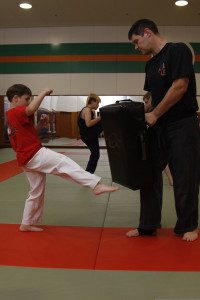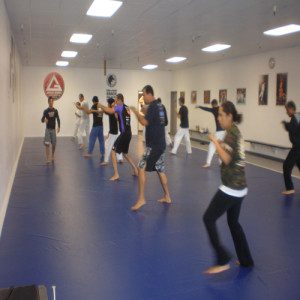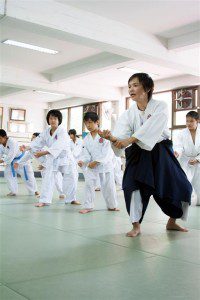Dojo Etiquette
Either is your first day of class or you consider yourself a veteran of Martial Arts, you should be aware of the proper etiquette toward your teacher, classmates and Dojo (or Gym).
The following list is originally made for Karate Dojo but I’m sure that most of the points are well applicable in any activity you engage in your Gym.
It’s a good reminder for respect and discipline for all martial artists.
Etiquette
 Karate begins and ends with courtesy and respect. Etiquette in the dojo is an important aspect of training as it is an outward expression of your martial arts awareness. By observing good dojo etiquette, you will be demonstrating proper understanding of your relationships with other students and the martial aspects of karate training.
Karate begins and ends with courtesy and respect. Etiquette in the dojo is an important aspect of training as it is an outward expression of your martial arts awareness. By observing good dojo etiquette, you will be demonstrating proper understanding of your relationships with other students and the martial aspects of karate training.
Before Class:
- Always be physically clean. Pay particular attention to your hands and feet. Avoid wearing strong cologne or perfume.
- Make your body safe for training. Remove any chewing gum or other loose objects from your mouth. Keep your fingernails and toenails trimmed short. Remove any jewelry, particularly earrings, bracelets, necklaces, and rings. Socks are not recommended, but karate shoes (no street shoes) may be worn.
- Make certain that your gi (uniform) is clean and wear it neatly. Wear the jacket with the left flap on the outside and tie the belt in a proper square knot. Karate pants are required, and a gi top is always appropriate. T-shirts are acceptable on hot days or under your gi top, but should never hang out below your jacket.
- As you enter the dojo, acknowledge your arrival with a bow towards the front part of the dojo or toward the Sensei.
- Come to class prepared to focus, listen, and learn. It is critical to enter into training with the proper frame of mind.
- If class has not yet begun, you may begin stretching or warming up on your own.
Beginning of Class:
- Bow to the Sensei as an indication of your readiness to begin practice. Listen to the announcements.
During Class:
- Put your best effort forward during the warm-up exercises.
 Try not to be late for class. If you are late, wait until the instructor acknowledges you and invites you to join in. Thank the instructor with a bow and join the class. If you have missed the warm ups, take time to stretch out at the back of the room. Then approach any group of students and ask to join them. Be quick and quiet – take your place as soon as possible.
Try not to be late for class. If you are late, wait until the instructor acknowledges you and invites you to join in. Thank the instructor with a bow and join the class. If you have missed the warm ups, take time to stretch out at the back of the room. Then approach any group of students and ask to join them. Be quick and quiet – take your place as soon as possible.- When the instructor determines that it is time to stop or change techniques, the instructor will clap or announce it verbally. Do not continue conversation/ practice after the instructor has announced the change. At that time, bow to your partner and move on to the next activity as instructed.
- If the instructor stops to provide clarification concerning a technique, listen attentively.
- Should you need to fix your gi during class, first bow to your partner to indicate the interruption in practice. Then step out while straightening your gi. When you are finished, return and bow to your partner to indicate your readiness to continue.
- Once class has started, never leave or re-enter the dojo without asking the instructor. To avoid leaving during class, use the facilities before class. If it is truly an emergency, you may ask to step out.
- During breaks, students are expected to manage themselves as if they were still in formal class, no roughhousing, running, or playing is acceptable. Bow as you leave and re-enter.
- When walking through the dojo, walk around groups of people to avoid interrupting their class.
- Always report any injury to the instructor.
- There is no shame in having to stop to catch your breath. Your partner can join another pair until you are ready to continue.
 Speaking while the Sensei is talking or demonstrating is considered very rude. Fidgeting is also rude, and is not tolerated. An obnoxious yawn can quickly earn pushups or some other form of discipline.
Speaking while the Sensei is talking or demonstrating is considered very rude. Fidgeting is also rude, and is not tolerated. An obnoxious yawn can quickly earn pushups or some other form of discipline.- Any time your Sensei or a higher rank offers to help you, always accept and listen closely with enthusiasm and proper respect. The higher ranks are always willing to help, do not be afraid to ask.
- If there is ever a discrepancy over the proper technique, take the issue to a black belt and do not argue.
- No slouching, leaning on walls, or sitting is allowed during class. Poor posture shows lack of enthusiasm to learn.
- A loud kiai is the perfect display of powerful spirit. The choice of sound and/or word is yours. Don’t be afraid to kiai loudly as this displays good spirit and will motivate everyone in the class, but never do it half-heartedly. When counting, count in whatever language you feel comfortable with, but make sure the counts are short, sharp, and spirited.
- Do not argue or try to excuse yourself for a mistake or a deficiency that the senior student tells you about. Karate is not about being embarrassed about your mistakes – rather about taking pride in your achievements. Take in all that you are being told, practice it on your own, then return with more questions if you have them. More often, you will find that everything makes sense once you put effort into it!
- Respect the upper ranks. They have put in the time and effort to learn martial arts. Respect them and they will be respectful towards you.
End of Class:
- At the end of class, straighten your gi and line up in an orderly row as at the beginning of class. Bow to the instructor as the instructor bows to you.
- After class is ended, bid farewell to your practice partners with a bow and thanks.
- Bow as you leave the dojo.
Testing Procedures:
- Though you chose when to pretest, the instructor has the right to allow you to test when s/he feels you are ready. If you are told you should wait until the next testing session, take this answer as words of encouragement to work harder to prepare for the next testing date.
- During a test, students must refrain from speaking unless asked a question by the instructor.
- NEVER ask when you will be promoted, this is extremely rude and can only add time to the length of your next promotion.
Observers / Parents:

- Do not interrupt class to chat. Do not correct your child/friend. This is the instructor’s job, who is in charge of the class and will correct the students. This allows you to focus your attention on learning.
- Keep distractions (phone calls, conversation) quiet and to a minimum. This includes small children.
- Though all students are welcome, children must know left from right and be able to pay attention throughout class.
Source:
Images:
Luigi Diamanti on www.freedigitalphotos.net
Cherry (photo taken at Aikikai Thailand)
Tags: discipline, etiquette, Martial Arts, respect, training, way of the warrior
 Try not to be late for class. If you are late, wait until the instructor acknowledges you and invites you to join in. Thank the instructor with a bow and join the class. If you have missed the warm ups, take time to stretch out at the back of the room. Then approach any group of students and ask to join them. Be quick and quiet – take your place as soon as possible.
Try not to be late for class. If you are late, wait until the instructor acknowledges you and invites you to join in. Thank the instructor with a bow and join the class. If you have missed the warm ups, take time to stretch out at the back of the room. Then approach any group of students and ask to join them. Be quick and quiet – take your place as soon as possible.